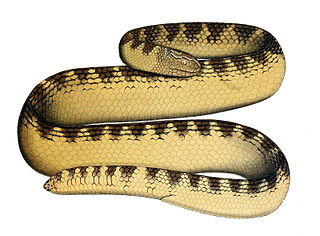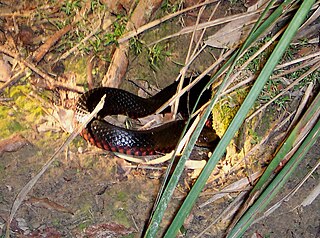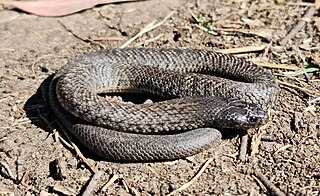
Elapidae is a family of snakes characterized by their permanently erect fangs at the front of the mouth. Most elapids are venomous, with the exception of the genus Emydocephalus. Many members of this family exhibit a threat display of rearing upwards while spreading out a neck flap. Elapids are endemic to tropical and subtropical regions around the world, with terrestrial forms in Asia, Australia, Africa, and the Americas and marine forms in the Pacific and Indian Oceans. Members of the family have a wide range of sizes, from the 18 cm (7.1 in) white-lipped snake to the 5.85 m king cobra. Most species have neurotoxic venom that is channeled by their hollow fangs, and some may contain other toxic components in various proportions. The family includes 55 genera with around 360 species and over 170 subspecies.

Acanthophis is a genus of elapid snakes. Commonly called death adders, they are native to Australia, New Guinea and nearby islands, and are among the most venomous snakes in the world. Despite their common name, they are not adders at all and belong to the Elapidae family. The name of the genus derives from the Ancient Greek akanthos/ἄκανθος ('spine') and ophis/ὄφις ('snake'), referring to the spine on the death adder's tail.

The red-bellied black snake is a species of venomous snake in the family Elapidae, indigenous to Australia. Originally described by George Shaw in 1794 as a species new to science, it is one of eastern Australia's most commonly encountered snakes. Averaging around 1.25 m in length, it has glossy black upperparts, bright red or orange flanks, and a pink or dull red belly. It is not aggressive and generally retreats from human encounters, but can attack if provoked. Although its venom can cause significant illness, no deaths have been recorded from its bite, which is less venomous than other Australian elapid snakes. The venom contains neurotoxins, myotoxins, and coagulants and has haemolytic properties. Victims can also lose their sense of smell.

Aipysurus eydouxii, commonly known as the beaded sea snake, the marbled seasnake, and the spine-tailed seasnake, is a species of venomous snake in the family Elapidae. A. eydouxii is unusual amongst sea snakes in that it feeds almost exclusively on fish eggs. As part of this unusual diet, this species has lost its fangs, and the venom glands are almost entirely atrophied.

Stokes's sea snake is a large species of sea snake in the family Elapidae. It is sometimes placed in its own genus Astrotia. The species is endemic to tropical Indo-Pacific oceanic waters.

Pseudechis is a genus of venomous snakes in the family Elapidae. It contains the group of elapid species commonly referred to as the black snakes. Species of Pseudechis are found in every Australian state with the exception of Tasmania, and some species are found in Papua New Guinea. They inhabit a variety of habitat types, from arid areas to swampland. All species are dangerous and can inflict a potentially lethal bite. Most snakes in this genus reach about 2 m (6.6 ft) in total length, and vary in colour. Some species are brown, whereas others are black. The most recognisable and widespread species in the genus are the red-bellied black snake and the mulga snake. These snakes feed on lizards, frogs, birds, small mammals, and even other snakes. All species of Pseudechis lay eggs with the exception of the red-bellied black snake P. porphyriacus which is viviparous. The genus Pailsus is a synonym of Pseudechis, and more work is needed to understand species limits among the smaller species of the group.

The king brown snake is a species of highly venomous snake of the family Elapidae, native to northern, western, and Central Australia. Despite its common name, it is a member of the genus Pseudechis and only distantly related to true brown snakes. Its alternative common name is the mulga snake, although it lives in many habitats apart from mulga. First described by English zoologist John Edward Gray in 1842, it is a robust snake up to 3.3 m (11 ft) long. It is variable in appearance, with individuals from northern Australia having tan upper parts, while those from southern Australia are dark brown to blackish. Sometimes, it is seen in a reddish-green texture. The dorsal scales are two-toned, sometimes giving the snake a patterned appearance. Its underside is cream or white, often with orange splotches. The species is oviparous. The snake is considered to be a least-concern species according to the International Union for Conservation of Nature, though may have declined with the spread of the cane toad.

Collett's snake, also commonly known as Collett's black snake, Collett's cobra, or Down's tiger snake, is a species of venomous snake in the family Elapidae. The species is native to Australia. Collett's snake is capable of delivering a fatal bite and is considered the nineteenth most venomous snake in the world.
Raymond Terrence Hoser is an Australian snake-catcher and author. Since 1976, he has written books and articles about official corruption in Australia. He has also written works on Australian frogs and reptiles. Hoser's work on herpetology is controversial, including his advocacy of the surgical alteration of captive snakes to remove their venom glands and his self-published herpetological taxonomy, which has been described as "taxonomic vandalism".
The spotted mulga snake, also known commonly as Butler's black snake and Butler's snake, is a species of venomous snake in the family Elapidae. The species is endemic to Western Australia. It is a member of the genus Pseudechis, dangerously venomous snakes that can intimidate an opponent by raising the head and presenting a hood. This cobra-like threat display is supported by the ability to produce a very large amount of venom.

The blue-bellied black snake, also known commonly as the spotted black snake, is a species of venomous snake in the family Elapidae. The species is native to Australia.

The coastal taipan, or common taipan, is a species of extremely venomous snake in the family Elapidae. Described by Wilhelm Peters in 1867, the species is native to the coastal regions of northern and eastern Australia and the island of New Guinea. The second-longest venomous snake in Australia, the coastal taipan averages around 2.0 m (6.6 ft) long, with the longest specimens reaching 2.9 m (9.5 ft) in length. It has light olive or reddish-brown upperparts, with paler underparts. The snake is considered to be a least-concern species according to the International Union for Conservation of Nature.
The Papuan black snake is a venomous snake of the family Elapidae native to New Guinea. Reaching around 2 m in length, it is a predominantly black snake coloured grey underneath.

The smooth-scaled death adder is a species of venomous snake in the family Elapidae. The species is endemic to Southeast Asia and Oceania.
The eastern dwarf mulga snake, also known commonly as the eastern pygmy mulga snake and the false king brown snake, is a species of venomous snake in the family Elapidae. The species, which is native to Australia, was genetically confirmed as a distinct species in 2017.
The Papuan pygmy mulga snake is a venomous snake of the family Elapidae native to New Guinea, genetically confirmed as a distinct species in 2017. It was originally described by Raymond Hoser in 2000 as Pailsus rossignolii, naming it for Victorian snake handler Fred Rossignoli.

The slender-necked sea snake, also known commonly as Cogger's sea snake, is a species of marine venomous snake in the subfamily Hydrophiinae of the family Elapidae. The species is native to waters around western Australia and the southern Pacific Ocean.
The estuarine sea snake, also known commonly as Kharin's sea snake, is a species of marine venomous snake in the family Elapidae. The species is native to waters around the northern tip of Australia in the Torres Strait.

The spectacled hooded snake, also known commonly as the Port Lincoln snake, is a species of venomous snake in the family Elapidae. The species is native to central-southern Australia. There are three recognized subspecies.
Laticauda guineai is a species of venomous sea snake in the family Elapidae. The species, which was first described by Heatwole, Busack and Cogger in 2005, is native to waters off southern New Guinea.












